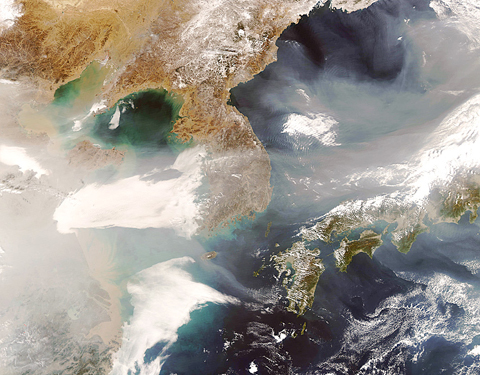A dirty brown haze sometimes more than 1km thick is darkening skies not only over vast areas of Asia, but also in the Middle East, southern Africa and the Amazon Basin, changing weather patterns and threatening health and food supplies, the UN reported.
The huge smog-like plumes, caused mainly by the burning of fossil fuels and firewood, are known as “atmospheric brown clouds.”
When mixed with emissions of carbon dioxide and other gases blamed for warming the earth’s atmosphere like a greenhouse, they are the newest threat to the global environment, a report commissioned by the UN Environment Program and released on Thursday said.

PHOTO: AP
“All of this points to an even greater and urgent need to look at emissions across the planet,” said Achim Steiner, head of Kenya-based UNEP, which funded the report with backing from Italy, Sweden and the US.
Brown clouds are caused by an unhealthy mix of particles, ozone and other chemicals that come from cars, coal-fired power plants, burning fields and wood-burning stoves. First identified by the report’s lead researcher in 1990, the clouds were depicted on Thursday as being more widespread and causing more environmental damage than previously known.
Perhaps most widely recognized as the haze this past summer over Beijing’s Olympics, the clouds have been found to be more than 1km thick around glaciers in the Himalayas and the Hindu Kush mountain range. They hide the sun and absorb radiation, leading to new worries not only about global climate change but also about extreme weather conditions.
“All these have led to negative effects on water resources and crop yields,” the report said.
Health problems associated with particulate pollution, such as cardiovascular and respiratory diseases, are linked to nearly 350,000 premature deaths in China and India every year, said Henning Rohde, a University of Stockholm scientist who worked on the study.
Soot levels in the air were reported to have risen alarmingly in 13 cities: Bangkok, Beijing, Cairo, Dhaka, Karachi, Kolkata, Lagos, Mumbai, New Delhi, Seoul, Shanghai, Shenzhen and Tehran.
Brown clouds were also cited as dimming the light by as much as 25 percent in some places, including Karachi, New Delhi, Shanghai and Beijing.
The phenomenon complicates the climate change scenario because the brown clouds also help cool the earth’s surface and mask the impact of global warming by an average of 40 percent, the report said.

The death of a former head of China’s one-child policy has been met not by tributes, but by castigation of the abandoned policy on social media this week. State media praised Peng Peiyun (彭珮雲), former head of China’s National Family Planning Commission from 1988 to 1998, as “an outstanding leader” in her work related to women and children. The reaction on Chinese social media to Peng’s death in Beijing on Sunday, just shy of her 96th birthday, was less positive. “Those children who were lost, naked, are waiting for you over there” in the afterlife, one person posted on China’s Sina Weibo platform. China’s

‘POLITICAL LOYALTY’: The move breaks with decades of precedent among US administrations, which have tended to leave career ambassadors in their posts US President Donald Trump’s administration has ordered dozens of US ambassadors to step down, people familiar with the matter said, a precedent-breaking recall that would leave embassies abroad without US Senate-confirmed leadership. The envoys, career diplomats who were almost all named to their jobs under former US president Joe Biden, were told over the phone in the past few days they needed to depart in the next few weeks, the people said. They would not be fired, but finding new roles would be a challenge given that many are far along in their careers and opportunities for senior diplomats can

Australian Prime Minister Anthony Albanese yesterday announced plans for a national bravery award to recognize civilians and first responders who confronted “the worst of evil” during an anti-Semitic terror attack that left 15 dead and has cast a heavy shadow over the nation’s holiday season. Albanese said he plans to establish a special honors system for those who placed themselves in harm’s way to help during the attack on a beachside Hanukkah celebration, like Ahmed al-Ahmed, a Syrian-Australian Muslim who disarmed one of the assailants before being wounded himself. Sajid Akram, who was killed by police during the Dec. 14 attack, and

RUSHED: The US pushed for the October deal to be ready for a ceremony with Trump, but sometimes it takes time to create an agreement that can hold, a Thai official said Defense officials from Thailand and Cambodia are to meet tomorrow to discuss the possibility of resuming a ceasefire between the two countries, Thailand’s top diplomat said yesterday, as border fighting entered a third week. A ceasefire agreement in October was rushed to ensure it could be witnessed by US President Donald Trump and lacked sufficient details to ensure the deal to end the armed conflict would hold, Thai Minister of Foreign Affairs Sihasak Phuangketkeow said after an ASEAN foreign ministers’ meeting in Kuala Lumpur. The two countries agreed to hold talks using their General Border Committee, an established bilateral mechanism, with Thailand